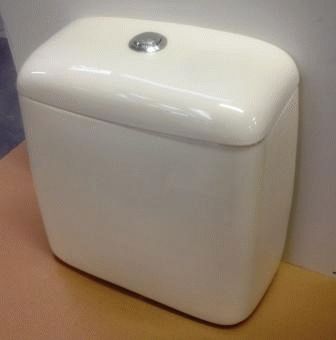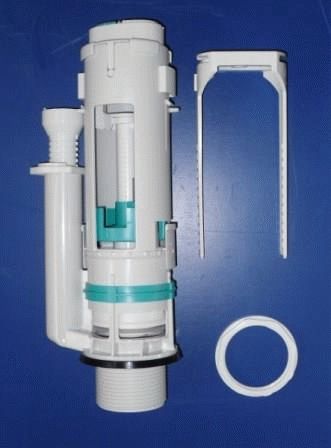When using any device, it becomes necessary to repair it. The toilet is also no exception, it periodically needs to replace the insides of the toilet cistern. The cause of a breakdown can be many factors: wear of parts and assemblies, damage to the structure, and more. Often it is necessary to fix the malfunction urgently, as this can threaten the flooding of the home. Therefore, we will consider all types of repairs regarding malfunctions of the insides of the tank.
The components of the cistern and their interaction
Opening the lid of the tank, components and assemblies are found inside that ensure the operation of the system for collecting and draining water. As a matter of fact, the insides of the tank consist of these two nodes. Let us consider in more detail how they work and interact with each other in order to learn how to fix all the breakdowns on their own.
- The water intake system consists of five elements: a flexible hose, a water intake fitting, a shut-off valve of the locking mechanism, a twist and the float itself. The work is as follows: on the one hand, a flexible hose is connected to a water pipe, on the other hand there is a connection with a fitting located inside the drain tank. Through the fitting, water enters the tank. The fitting valve is “responsible” for water collection, the operation of which is based on the principle of a locking mechanism. In the open position of the valve - water flows, when the valve closes - it stops. The level of water intake is adjusted by the “twisting-float” unit. When the float is in the low position, the valve opens, when the float rises as water fills, it closes.
- The second node that makes up the inside of the tank is the water drain system. It consists of a button or chain that drives the opening mechanism of the lower drain valve, the valve itself and a lever - a system through which the button and valve communicate. Everything is simpler here and no locking mechanism is required, since after the water has poured out of the tank, the valve will close automatically under the influence of gravity.
- Thus, the systems interact with each other at the moment the tank is empty, when the drain valve closes, and the float reaches the minimum location level, opening the shut-off valve of the fitting.
We repair the float and eliminate all types of leaks
We proceed directly to the guide "how to repair the insides of the toilet cistern." There can be several consequences of malfunctions, depending on what exactly is broken.
- Water won't stop flowing into the toilet. Here, the breakdown lies in the float, twist or shutoff valve. After long-term operation, the surface of the float may become cracked or it may simply crack in one place, then when taking in water, it will float up late, and water will constantly be drawn. In this case, the float can simply be replaced. Another reason is that a metal twist was bent or a plastic ratchet cracked, through which the impulse from the float was transmitted to the valve, then the metal can always be straightened, but the plastic will also have to be changed. If the valve does not close, then an additional float valve can be installed, since, most likely, the valve cannot cope with the water pressure.
- The set of water is accompanied by a loud noise. There are two ways to fix this defect:
- change the diameter of the hole through which water is poured;
- insert a small tube about 35 cm long into the hole, then the water will pass through it and the noise from filling the tank will decrease significantly.
- The cistern leaks straight to the floor. It means you have broken bolts. It's very easy to find out.

A malfunction may not always appear immediately, so within a couple of days, watch for condensation and leaks.
- A situation arises when water constantly flows into the tank. This means that the water drain system is faulty in the part of the drain valve or the lever itself. This is likely to require replacement. Doing it yourself is quite simple.
- remove water from the toilet;
- remove the entire system;
- change it to a new one;
- fill the tank with water and check for performance.
Since the entire system is sold as an assembly, both valve and lever will be replaced at the same time.
- If water does not enter, this means that the fluid collection system is faulty. There are three possible breakdowns.

We completely change the armature
If you have no desire to study what exactly broke in the insides of your cistern, you can simply replace all the components in one go. Depending on the type of tank, the fittings inside it are also different, so do not rush to throw away the old design, it can be demonstrated in the store for an error-free purchase of a new set. The instructions for dismantling and installation are quite simple:
- Turn off the water first.
- Unscrew the top button and carefully remove the cover. You can put it aside, you will need it at the very end.
- Next, unscrew the fitting liner, remove the typesetting system.
- Disconnect the lever with the drain valve and pull it out.
- After the tank is empty, we begin the installation of new fittings in the reverse order - as it was disassembled.
Of the tools, you only need pliers and keys.

Choosing the right fixture
In order to change the inside of the tank as little as possible, you need to be able to choose them correctly. Consider the subtleties of choice. When buying, you need to know that all the insides of the toilet are divided into two groups:
- Depending on the material from which the mechanisms are made, there are plastic "stuffing" and metal alloys, mainly brass. Metal components ensure the durability of parts and resistance to breakage. Plastic parts wear out faster and require replacement and repair more often. But there is also a gradation in plastic, very cheap plastic will break quickly, and better quality will last longer, but it’s difficult to determine its quality by eye, so you should be guided by the price - the more expensive, the better.
- By the type of design itself, separate nodes for collecting and draining water and complex systems that combine these two nodes are distinguished. With a separate system, everything is clear, the connection between them is carried out through third-party influence - pressing a button. This configuration is advantageous in that the worn part can be repaired or replaced independently. The general adjustment system independently manages the processes as a whole. Such a system is installed only on modern models of tanks. It is quite difficult to install and operate, so its repair should be entrusted to a specialist. But such difficulties are justified by the impeccable work of the drain tank.
Also, the insides of the toilet bowl differ in the way the fitting is installed: bottom or side, right, left. Therefore, if you purchase fittings to replace worn ones, then you need to buy, taking into account the design features. In addition, systems often differ from each other even in the diameter of technological holes. Therefore, when choosing fittings, take this process responsibly so that you do not have to purchase additional devices or change purchased items.


















